X - Female Genital System
Editors: Mills, Stacey E.
Title: Histology for Pathologists, 3rd Edition
Copyright 2007 Lippincott Williams & Wilkins
> Table of Contents > XI - Endocrine > 48 - Paraganglia
function show_scrollbar() {}
48
Paraganglia
Arthur S. Tischler
Introduction
Paraganglia are anatomically dispersed neuroendocrine organs associated with the autonomic nervous system and characterized by morphologically and cytochemically similar neurosecretory cells derived from the neural crest. For many physiological and pathophysiological purposes, they may be considered to comprise two groups associated with either sympathetic or parasympathetic nerves. Sympathetic paraganglia are distributed along the prevertebral and paravertebral sympathetic chains and along sympathetic nerve branches that innervate the organs of the pelvis and retroperitoneum. The adrenal medulla is the most extensively studied and best understood example of the sympathetic paraganglia. Parasympathetic paraganglia are predominantly distributed along cervical and thoracic branches of the glossopharyngeal and vagus nerves. The prototypical parasympathetic paraganglion is the carotid body.
History and Nomenclature
The history of the paraganglia is among the more interesting and controversial in the recent annals of medicine. This material is addressed in detail in several excellent reviews (1,2,3,4). The concept of a unitary paraganglionic system was first proposed by Alfred Kohn at the beginning of the 20th century (5). Several earlier investigators had developed histochemical reactions demonstrating that the adrenal medulla contained substances chemically different from those in the adrenal cortex. The reaction that proved
P.1212
most significant from a historical perspective, development of brown coloration in the presence of chromate salts, was apparently first discovered by Bertholdus Werner in 1857 (3). Kohn coined the terms chromaffin reaction for the color change and chromaffin cells for the reactive cells, which he described in several extra-adrenal locations in the retroperitoneum. He further noted that some cells in the carotid body exhibited a chromaffin reaction, confirming an earlier report by Stilling (3). Kohn believed that the reactive carotid body cells were derived from precursors of sympathetic ganglia and were innervated by sympathetic axons, and he suggested that they were therefore embryologically, histochemically, and functionally comparable to retroperitoneal chromaffin cells. He proposed a new term to encompass all the tissues composed of cells that were analogous to neurons, but not neuronal: Since the chromaffin tissue complexes form ganglion-like bodies, since their elements are derived from ganglion anlagen, since they are connected to the sympathetic nervous system and still are not genuine ganglia, I have called them paraganglia (5); translated from German by Dr. Miguel Stadecker).
Obstacles to acceptance of Kohn's concept soon arose from DeCastro's finding that the innervation of the carotid body is primarily derived from the glossopharyngeal nerve (4), and from observations by many investigators that carotid body cells are usually nonchromaffin. Consequently, Watzka (4) divided the paraganglion system into chromaffin and nonchromaffin paraganglia, associated respectively with the sympathetic or parasympathetic nervous systems, and paraganglia of mixed type. Discovery of the chemoreceptor function of the carotid bodies created further difficulties since it implied that the nonchromaffin paraganglia served physiologically in a sensory role, in contrast to the endocrine function of the adrenal medulla. The suggestion was therefore made by Kjaergaard that the parasympathetic paraganglia be referred to by the term chemodecton (from the Greek dechesthai, to receive). This name was never widely accepted, despite the earlier application by Mulligan of its counterpart, chemodectoma, to paraganglionic tumors (4).
An additional synonym for the parasympathetic paraganglia is glomus (from the Latin glomus, ball). This term is a vestige of a 19th-century hypothesis that the carotid body is of vascular origin (4). Although it aptly describes the microscopic Zellballen characteristic of paraganglia, it has caused confusion because it is also applied to thermoregulatory structures in the skin and other locations (e.g., glomera cutanea and the glomus coccygeum) and to their corresponding tumors (glomus tumors or glomangiomas). Those structures are modified arteriovenous anastomoses unrelated to paraganglia developmentally or functionally.
It is now possible to return to a unitary concept of paraganglia with a synthesis of new and old data. Paraganglionic neuroendocrine cells are probably all derived from the neural crest (6,7). All produce catecholamines or, in some cases, indolamines (6,8) detectable by more sensitive methods than the chromaffin reaction, and all express multiple additional neuroendocrine markers (9). Recently, chemosensory properties previously considered specific to parasympathetic paraganglia have been documented in cells derived from sympathetic paraganglia as well (10). It is now apparent that the same basic type of neuroendocrine cell may be used differently in different anatomic locations (9,11,12). The term paraganglion connotes a constellation of generic characteristics of this type of cell without being dependent on a single histochemical reaction. Since paraganglion was intended by Kohn to imply analogy, rather than merely proximity, to autonomic ganglia, it continues in this context to be both conceptually helpful and literally correct. The chromaffin reaction as a basis for classification of paraganglia is now obsolete. However, reference to the reaction persists for historical reasons. Chromaffin cell is the name generally accepted for the neuroendocrine cells of the normal adrenal medulla and sometimes still applied to their extra-adrenal counterparts associated with the sympathetic nervous system. Similarly, pheochromocytoma (from the Greek phaios, dusky, + chroma, color), the name applied by convention to chromaffin cell tumors, refers to the color change imparted by the chromaffin reaction.
Sympathetic Versus Parasympathetic Paraganglia: A Clinicopathologic Perspective
Sympathetic and parasympathetic paraganglia differ from a clinicopathologic standpoint despite their similarities at the cellular level. This contrast might result from differences in the type, timing, or intensity of physiological signals to which the two classes of paraganglia are exposed during development or in adult life. The only pathologic changes known to be clinically important in paraganglia are hyperplasia and neoplasia. Several generalizations concerning these proliferative lesions underscore the differences between paraganglia of the sympathetic and parasympathetic classes: when multiple lesions occur within families or individuals, they are usually confined to one or the other class. Although both sympathetic and parasympathetic lesions produce catecholamines, clinical signs of excess catecholamine secretion are usually associated with lesions that are sympathetic, and lesions that produce significant amounts of epinephrine are almost invariably sympathetic. Lesions that occur in patients with prolonged hypoxemia or hypercapnia are almost invariably parasympathetic. In addition, sympathetic paraganglia give rise to tumors of both neuronal lineage (i.e., neuroblastomas, ganglioneuroblastomas, and ganglioneuromas) and neuroendocrine lineage (pheochromocytomas and extra-adrenal paragangliomas),
P.1213
while neoplasms of parasympathetic paraganglia are almost always of neuroendocrine lineage. Neuronal tumors are most common in children, while neuroendocrine tumors usually occur in adults.
Despite the differences in the contexts in which they arise, sympathetic and parasympathetic paragangliomas strongly resemble each other microscopically and are often indistinguishable. They also exhibit a widely overlapping range of secretory products and other neuroendocrine markers, reflecting the similarities of the neuroendocrine cells that are their normal counterparts. A morphologic foundation for the study of paraganglionic pathology therefore requires familiarity with both systemic differences and cellular similarities.
A need for deeper understanding of the differences and similarities between paraganglia in different locations has become apparent as a result of recent advances in characterizing the genetic abnormalities and gene expression profiles of pheochromocytomas and extra-adrenal paragangliomas. Hereditary syndromes now known to be associated with development of pheochromocytomas are Multiple Endocrine Neoplasia (MEN) 2A and 2B, von Hippel-Lindau disease, neurofibromatosis type 1 and familial paraganglioma/pheochromocytoma syndromes, due respectively to mutations of the RET protooncogene, VHL and NF1 tumor suppressor genes, and SDHD, SDHB, and SDHC succinate dehydrogenase genes (13,14). Extra-adrenal paragangliomas are rare in MEN2 and neurofibromatosis, and those that occasionally do occur often arise in the vicinity of the adrenal. In contrast, VHL tumors, while predominantly intra-adrenal, are not uncommon in extra-adrenal locations and tumors associated with succinate dehydrogenase mutations are predominantly extra-adrenal (13). The combination of sympathetic and parasympathetic paragangliomas may be particularly suggestive of succinate dehydrogenase mutations (13). Microarray-based gene expression profiling studies complemented by immunohistochemical and/or biochemical analyses have revealed sets of markers that tend to be clustered in tumors with specific genetic backgrounds. For example, genes associated with hypoxia-driven transcription pathways are preferentially expressed in VHL tumors (15). An additional distinctive characteristic of VHL tumors is that they usually produce exclusively norepinephrine, while MEN2 and NF1 tumors produce both epinephrine and norepinephrine (16). Some genotype phenotype correlations may be accounted for by characteristics of the predominant anatomic sites of tumor origin; for example, the fact that epinephrine production is normally confined to the adrenal medulla. However, the basis for different gene expression clusters in tumors at any given location is for the most part poorly understood. One possibility is that subtle types of cellular heterogeneity within normal paraganglia might allow for different cells of origin predisposed to respond to distinct genetic abnormalities. Alternatively, distinct genetic abnormalities initiating tumors in a single cell type could produce distinct signatures.
Distribution of Paraganglia
Sympathetic paraganglia are found predominantly in the para-axial regions of the trunk along the prevertebral and paravertebral sympathetic chains and in connective tissue in or near the walls of the pelvic organs. In adult humans, they are especially numerous along the fibers of the inferior hypogastric plexuses leading to and entering the urogenital organs, in the wall of the urinary bladder, and among the nerve fibers of the sacral plexus (17,18,19,20) (Figure 48.1). They are not generally known by individual names, and their precise locations are variable. Exceptions are the adrenal medulla and the organ of Zuckerkandl, located at the origin of the inferior mesenteric artery (21) (Figures 48.1 and 48.2).
P.1214
The distinctive characteristic of the organ of Zuckerkandl is that it is the only extra-adrenal sympathetic paraganglion that is macroscopic. Historically, it is said to have been shown initially to Alfred Kohn as an unusual lymph node by his pupil, Emil Zuckerkandl (4,22). In its most frequent anatomic configuration, it is divided into a set of paired organs (Figure 48.2), and it is therefore often referred to by the plural, organs of Zuckerkandl (1). Because its fragmentation and its proximity to numerous smaller paraganglia may make it difficult to identify precisely, some investigators have used the plural to encompass all preaortic paraganglia between the inferior mesenteric artery and the aortic bifurcation (23). However, this chapter maintains the traditional, more specific, macroscopic usage.
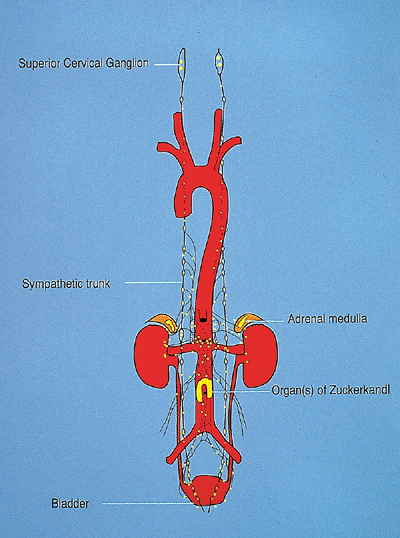 |
Figure 48.1 The distribution of sympathetic paraganglia in the human fetus. (Adapted with permission from: Coupland RE. The Natural History of the Chromaffin Cell. London: Longmans Green; 1965 ;Glenner GG, Grimley PM. Tumors of the extraadrenal paraganglion system (including chemoreceptors). In: Atlas of Tumor Pathology. 2nd series, fascicle 9. Washington, DC: Armed Forces Institute of Pathology; 1974. ) |
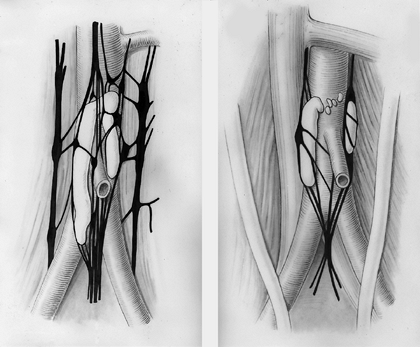 |
Figure 48.2 Modified renditions of original illustrations by Zuckerkandl (21) representing the anatomic structure that bears his name. The bilobed configuration with a fragmented isthmus (right) is the most frequent variation. (Courtesy of Dr. E. E. Lack.) |
Neuroendocrine cells are present both within and adjacent to the ganglia of human sympathetic chains. The former have been referred to in neurobiology literature as small intensely fluorescent (SIF) cells (24), intraganglionic chromaffin cells (25), or small granule-containing (SGC) cells (11,12), depending on the particular technique used to detect them. In pathology literature especially, SIF cells are often regarded as intraganglionic paraganglia (26). In anatomy literature, on the other hand, some investigators reserve the term paraganglia for extraganglionic sites (24).
In contrast to sympathetic paraganglia, their parasympathetic counterparts are distributed almost exclusively along the cranial and thoracic branches of the glossopharyngeal and vagus nerves (Figure 48.3). With the exception of the carotid bodies, which are located between the carotid arteries just above the carotid bifurcation (Figure 48.4), parasympathetic paraganglia are highly variable in both number and location (4). Their names refer to general locations, rather than to specific structures. The middle ear, for example, contains 0 to 12 jugular and tympanic paraganglia, with an average of 2.8 (27). The principal paraganglia of the glossopharyngeal nerve are the tympanic paraganglia in the wall of the middle ear and the carotid bodies (4,27). Those of the vagus nerve include the jugular paraganglia in the floor of the middle ear (4,27), the superior and inferior laryngeal paraganglia (4,27,28), and the subclavian and aorticopulmonary or cardioaortic paraganglia near the bases of the great vessels of the heart. They sometimes also may be found in the interatrial septum (4). In addition, intravagal paraganglia are located within or adjacent to the vagal trunk in or near the nodose and jugular ganglia (4). These two vagal ganglia are thus the only sensory ganglia known to contain neuroendocrine cells comparable to the SIF cells of sympathetic ganglia. These cells have been described as SIF cells in some publications (29).
Some investigators have classified the parasympathetic paraganglia as branchiomeric (26). This nomenclature is based on the suggestion that the branchial arches during embryogenesis are metameric, or serially homologous, structures, each with its own artery, cranial nerve branches, and associated paraganglia. The carotid body would accordingly develop in association with the glossopharyngeal nerve and the third branchial arch artery, which persists as the internal carotid. Subclavian paraganglia would develop with the vagus nerve and the fourth branchial arch artery, and so on. The evolution of this concept is reviewed elsewhere in detail (4). However, the concept does not contribute to the understanding the pathophysiology of paraganglia and may cause confusion by distracting attention from the important differences between parasympathetic
P.1215
and sympathetic paraganglia, which may occur in close proximity to each other (e.g., the carotid bodies and the SIF cells in cervical sympathetic ganglia). It also is plagued by a number of internal inconsistencies, such as its prediction that the temporal paraganglia should be innervated by the facial nerve (4).
 |
Figure 48.3 The distribution of the principal parasympathetic paraganglia. (Adapted with permission from: Glenner GG, Grimley PM. Tumors of the extraadrenal paraganglion system (including chemoreceptors). In: Atlas of Tumor Pathology. 2nd series, fascicle 9. Washington, DC: Armed Forces Institute of Pathology; 1974. ) |
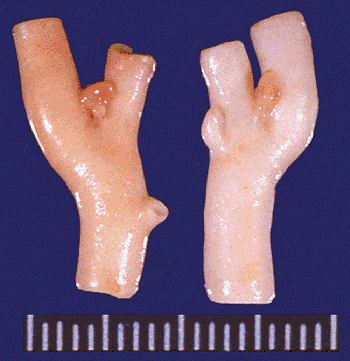 |
Figure 48.4 Gross specimens from a 5-year-old girl, illustrating normal carotid bodies and their relationship to the carotid arteries. (Courtesy of Dr. E. E. Lack.) |
Knowledge of the distribution of normal paraganglionic tissue is important because of its value in predicting the sites of origin of paragangliomas. These tumors have been reported at virtually all locations where normal paraganglia are found during fetal or adult life and tend to be most frequent in areas where paraganglionic tissue is most abundant. For example, in early childhood a high percentage of paraganglionic tissue is extra-adrenal (see Embryologic Changes and Postnatal and Developmental Changes ). Approximately half of all sympathetic paragangliomas in children are also extra-adrenal, most frequently arising in the vicinity of the organ of Zuckerkandl, while only about 10% are extra-adrenal in adults (30). However, it is also important to note that paraganglia may occur in locations outside the well-established sympathetic and parasympathetic distributions, perhaps explaining the existence of paragangliomas in unusual locations. Although intravagal paraganglia in humans have been identified only in the cervical and thoracic portions of the vagus nerve (31), in
P.1216
rodents they are also present within the abdominal portions (32). It has not been ruled out that some abdominal paraganglia in humans, for example, in the gallbladder (33) (Figure 48.13), may be associated with small abdominal vagus nerve branches. In scattered reports, paraganglia have been described in various sites including the orbit, mandible, and extremities. The validity of some of these reports is questionable (4).
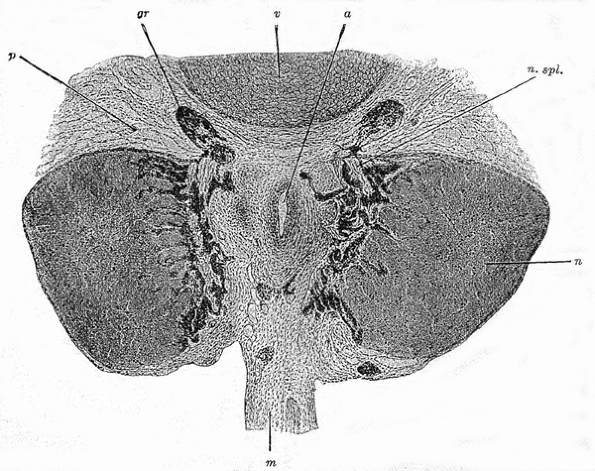 |
Figure 48.5 Original illustration by Zuckerkandl of a transverse section of a human embryo (17 mm crown heel length) showing presumed migration of primitive sympathetic cells into the adrenal glands. The darkly stippled masses traversed by nerves are the primitive sympathetic cells. a, aorta; gr, developing sympathetic ganglia; n. spl, splanchnic nerve; v, vertebra; p, peritoneal cushion; m, mesentery; n, adrenals. (Reprinted with permission from: Zuckerkandl E. The development of the chromaffin organs and of the suprarenal glands. In: Keibel F, Mall FP, eds. Manual of Human Embryology. Philadelphia: JB Lippincott; 1912. ) |
Embryologic Changes
During embryogenesis, the paraganglia are first populated by small, primitive cells similar to those in the anlage of the sympathetic ganglia. These cells include precursors of neuroendocrine, neural, and glial cell lineages in adult paraganglia (34,35) (see Light Microscopy ). They appear to be able to produce some catecholamines at the earliest stages of paraganglionic development (35,36) (see Function ), and express cytoskeletal or other markers of immature neurons (35), or glia (35) (see Special Procedures ). They are readily recognized in the paraganglia at about 7 weeks' gestation, although they first arrive somewhat earlier (1), and they are progressively superseded by larger, differentiated, cells. Extra-adrenal sympathetic (1) and parasympathetic (36,37) paraganglia mature cytologically earlier than the adrenal medulla. Primitive cells usually disappear from these locations by week 25 but may persist in small numbers in the adrenal medulla until after birth (1).
Classic, descriptive, embryologic studies (38,39) show primitive sympathetic cells in large numbers around the spinal nerves and branches of the developing sympathetic trunks before the formation of the paraganglia. The cells are also described along the renal and spermatic arteries (39). The adrenal medulla is apparently colonized by invasion of primitive sympathetic cells into the cortex through the medial aspect of the capsule from the contiguous prevertebral and paravertebral sympathetic tissue (Figure 48.5). The invading cells initially form nodular aggregates in the cortex (Figure 48.6) and gradually coalesce around the central vein. They may form rosettes or pseudorosettes early
P.1217
in gestation (1,40). Chromaffin cells are identifiable among these aggregates from about week 8 on (1,40) and gradually increase in number. The centripetal pattern of migration of primitive sympathetic cells into the adrenal may result in subcapsular and intracortical chromaffin cell rests (see Figure 48.25). Although some primitive sympathetic cells appear to penetrate the cortex along sympathetic nerve fibers, some are apparently not associated with nerve fibers (1). Innervation of the presumptive medulla by preganglionic nerve fibers does not appear to be necessary for colonization because experimental studies demonstrate that the medulla can form in adrenal primordia from 4- or 5-day chick embryos explanted to chorioallantoic membranes before the onset of innervation (41).
 |
Figure 48.6 Section of adrenal gland from a 16-week human fetus showing typical aggregates of primitive sympathetic cells that are precursors of the medulla. Pyknotic nuclei and nuclei with changes consistent with apoptosis are present within the aggregates. Many of the small cells express immunoreactive tyrosine hydroxylase, the rate-limiting enzyme in catecholamine synthesis, but do not stain for CgA or synaptophysin, which are characteristic of larger, mature, or maturing chromaffin cells (35). Scattered S-100 positive cells consistent with the sustentacular cell lineage are observed at about week 20 (34). |
Nodular aggregates of primitive sympathetic cells, up to 400 m in greatest dimension, can be demonstrated in the adrenal glands of all human fetuses between the ages of 10 and 30 weeks if the glands are thoroughly sectioned (42). Aggregates with a diameter of over 1 mm may occasionally be observed (40). Nerve fibers may connect intra-adrenal and extra-adrenal aggregates (42). The nodules peak in size and number between the ages of 17 and 20 weeks and then decline. Intranodular cystic degeneration is common from the age of 20 weeks onward (42). Postnatal persistence of the nodules was apparently first described by Wiesel in 1902 (38). These occasional persistent nodules may account for some erroneous diagnoses of in situ neuroblastoma (42,43) (see Differential Diagnosis ).
Primitive cells can be observed apparently migrating to developing parasympathetic paraganglia along branches of the glossopharyngeal and vagus nerves as well as from sympathetic nerves (37). The nature, origin, and fate of these cells from different sources and their respective contributions to the mature paraganglia were vigorously debated for more than 70 years (4,37). It is of interest that both the purely morphologic studies of Kohn et al. (38) and later histochemical studies (36) suggest an origin of the neurosecretory cells of the human carotid body, the prototypical parasympathetic paraganglion, from the sympathetic progenitors of the superior cervical ganglion.
Postnatal and Developmental Changes
The amount or distribution of paraganglionic tissue is known to change during development and aging. Sympathetic paraganglionic tissue in fetuses and neonates is primarily extra-adrenal, with the greatest volume in the organ of Zuckerkandl. The organ of Zuckerkandl develops maximally in humans by the age of about 3 years, when its greatest dimension may be more than 20 mm. Thereafter, the organ involutes (1,20), while the adrenal medulla enlarges until maturity. Similarly, SIF cells are present in all human sympathetic ganglia at birth but are rare in adults (1). Parasympathetic paraganglionic tissue also appears to decrease in some locations and to increase in others. Subclavian and intrapulmonary paraganglia, for example, have been identified in human fetuses but not in adults (4). On the other hand, the number of jugular and tympanic paraganglia apparently increases after birth (27). The carotid bodies, which are the only parasympathetic paraganglia that are macroscopic, increase in size between infancy and adult life, when they are normally about 3 mm in greatest dimension (4) (Figure 48.4).
The mechanisms involved in developmental remodeling of the paraganglionic system may hold a number of clues to the pathobiology of paraganglionic tumors. It is generally accepted that apoptosis plays a critical role in the development of both the central and peripheral nervous systems, where excess neural progenitor cells undergo apoptotic death after failing to establish functional contacts or receive appropriate tropic substances from target tissues (44,45). There have been few studies of apoptosis that are specifically focused on the paraganglia. However, apoptotic bodies can be identified within the aggregates of primitive sympathetic cells in the adrenal medulla (Figures 48.6 and 48.7).
Phenotypic Plasticity
Adult human adrenal chromaffin cells are able to transdifferentiate into sympathetic neurons when removed from their in vivo environment and exposed to appropriate neurotrophic signals (46) (Figure 48.8). Capacity to undergo this fascinating metamorphosis is retained to varying degrees by developing or adult chromaffin cells from other species (47). The extent to which it is expressed in various extra-adrenal paraganglia has not been fully explored.
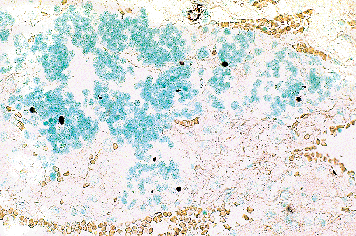 |
Figure 48.7 Section of the same adrenal as in Figure 48.6 showing terminal deoxynucleotidyl transferase mediated end-labeling (48) of nuclei within a neuroblastic aggregate (black nuclei). This method, which detects fragmented DNA, can be helpful in locating apoptotic cells. (Courtesy of Dr. Salvador Diaz-Cano.) |
P.1218
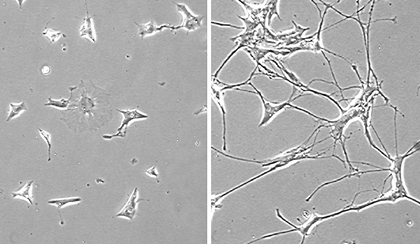 |
Figure 48.8 Phenotypic plasticity of normal adult human adrenal chromaffin cells demonstrated by acquisition of neuron-like morphology in cell culture. Cells at left were maintained in control medium for 2 weeks and those at right were in medium supplemented with nerve growth factor (46). (Courtesy of Dr. James F. Powers.) Capacity to undergo this trans-differentiation is exhibited to varying degrees by chromaffin cells from other species and from other normal or neoplastic paraganglia (47). |
Gross Features and Organ Weights
The paraganglionic tissue of the grossly identifiable paraganglia is gray or gray pink. Recognition of this feature is particularly important in the adrenal gland because the medulla is normally confined to the head and body of the gland but extends into the tail and alae in adrenal medullary hyperplasia (49,50). An accurate gross examination requires that the brown tissue of the cortical zona reticularis not be misidentified as medulla.
Because of the anatomic variability of the microscopic paraganglia and the organ Zuckerkandl, meaningful weights can be ascribed only to the adrenal medulla and carotid bodies. Extensive morphometric studies (51) have shown that the neonatal adrenal medulla accounts for approximately 0.4% of the total volume of the gland and weighs approximately 0.012 g. These values increase to 4.2% and 0.08 g at 2 years of age, 7.0% and 0.28 g between the ages of 10 and 13 years, and 9.9% and 0.46 g in adults up to the age of 40 years. After the age of 40 years, there is a small decline in medullary weight and volume. The weight of the carotid bodies appears to correlate more closely with body weight than with age. Lack (52) has proposed an equation to estimate carotid body weight from body weight for any age group: combined weight of carotid bodies (mg) = 0.29 body weight (kg) + 3.0. Standard deviations for any age group are large (53), but in normal adults the combined weight is usually less than 30 mg. The carotid body increases in size and weight in individuals living at high altitudes (54) and in patients with hypoxemia due to a variety of ailments (55,56,57,58).
Anatomy
All paraganglia are highly vascular, a characteristic that permits them to be localized by leakage of systemically injected dye in animal studies (59). However, the details of their blood supply are highly varied according to their location and function. For example, the adrenal medulla receives arterial blood from three arteries the inferior phrenic artery, aorta, and renal arteries and drains via a single adrenal vein that empties into the renal vein on the left and the aorta on the right. The carotid body receives arterial blood from one or occasionally two small arteries arising from the vicinity of the carotid bifurcation and drains via several small veins into the pharyngeal, superior laryngeal, and lingual veins (4).
The innervation of paraganglia is comparably site specific. In general, sympathetic paraganglia receive preganglionic cholinergic sympathetic innervation and variable amounts of noradrenergic and/or peptidergic innervation from intrinsic neurons, nearby sympathetic ganglia, and other sources. Most of the neuroendocrine cells in the adrenal medulla are innervated (60), in contrast to the sparse innervation of extra-adrenal sympathetic paraganglia (1,61), and it has been suggested that the ability of paraganglia to attract or maintain innervation might determine the extent to which they persist or involute at different sites (11). Parasympathetic paraganglia generally receive their innervation from branches of either the vagus or glossopharyngeal nerves but also may receive some sympathetic input. A small percentage of carotid body cells, for example, reportedly synapse with preganglionic sympathetic fibers (62). Some carotid body cells also may lack innervation (63). In addition to innervation that directly involves neuroendocrine cells, paraganglia may receive vasomotor innervation from the nearby superior cervical ganglion and from a small number of intrinsic neurons (62,64). Multiple peptide neurotransmitters have been identified in nerve endings innervating the carotid body, and dynamic alterations of innervation have been reported in response to hypoxic stress (65). Multiple neurotransmitters are also present in adrenal medullary nerve endings and play a variety of roles in regulating both the development and function of adrenal chromaffin cells (66).
P.1219
The neurovascular relationships of individual parasympathetic paraganglia have been described in great detail by several investigators (4,37). Of particular interest to pathologists are the paraganglia that give rise to glomus jugulare and glomus tympanicum paragangliomas in the floor or the wall of the middle ear. The paraganglia in the human temporal bone are distributed along the auricular branch of the vagus nerve (Arnold's nerve), and the tympanic branch of the glossopharyngeal nerve (Jacobson's nerve) (27). About 70% of paraganglia related to Arnold's nerve occur on the jugular bulb. The remainders follow the nerve through the mastoid canaliculus toward the vertical portion of the facial nerve. Paraganglia along Jacobson's nerve occur anywhere from the origin of the nerve at the petrosal ganglion (10%) to the jugular bulb (28%), tympanic canaliculus (40%), promontory of the middle ear (20%), and beyond (2%). Glomus jugulare tumors may therefore be associated with either Arnold's or Jacobson's nerve, although the former is most likely. Glomus tympanicum tumors are almost always associated with Jacobson's nerve (4).
Light Microscopy
Cell Types
Paraganglia contain two major types of cell: neuroendocrine cells and supporting cells. The former have been referred to in many publications as granule-containing cells. chromaffin cells, or chromaffin-like cells in sympathetic paraganglia and glomus cells, type I cells, or chief cells in parasympathetic paraganglia. The latter also have been called sustentacular cells, satellite cells, supporting cells, or type II cells (4,26). In addition, there are variable numbers of connective tissue cells, vascular cells, Schwann cells, myelinated or unmyelinated nerve fibers, and intrinsic neurons. An additional commonly encountered cell type is the mast cell, which may be abundant in both ganglia and paraganglia (4,67). In hematoxylin and eosin (H&E) stained sections, paraganglionic neuroendocrine cells are polygonal cells with amphophilic or basophilic cytoplasm and small, spherical or ovoid, pale-staining nuclei. Immunocytochemical stains for neuroendocrine markers can easily confirm their identity (see Special Procedures ). Electron microscopy or argyrophil-type silver stains to demonstrate secretory granules or fluorescence methods to demonstrate catecholamines are employed in older publications. The neuroendocrine cells in paraganglia tend to form clusters and cords, described as Zellballen and Zellstr ngen by Alfred Kohn (5), and may be partially or completely surrounded by supporting cells. The latter are usually flattened, with less conspicuous cytoplasm and more deeply basophilic nuclei with coarsely clumped chromatin. They appear to be glial cells, possibly related to non myelin-forming Schwann cells elsewhere in the peripheral nervous system (68), and can be identified by staining for S-100 protein (69) (see Special Procedures ). Like non myelin-forming Schwann cells, they have been reported in some instances to also stain for glial fibrillary acidic protein (70). They are present in both parasympathetic (69,70) and sympathetic (71,72) paraganglia but are more numerous in the former, where they cause the Zellballen to appear more pronounced (Figures 48.9,48.10,48.11,48.12).
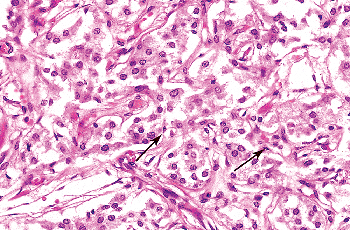 |
Figure 48.9 Section of organ of Zuckerkandl from a mid-trimester human fetus, demonstrating typical cords and nests of chief cells with rounded or oval nuclei and amphophilic cytoplasm, and occasional interspersed sustentacular cells with flattened nuclei and inconspicuous cytoplasm (arrows). |
Lobular Architecture of the Carotid Body
The carotid body is architecturally distinctive in that it consists of lobules separated by connective tissue septa (Figure 48.14).
P.1220
Each lobule is individually reminiscent of the microscopic paraganglia that occur in other sites and is composed of nests of chief cells surrounded by other cell types. This lobular arrangement is important to pathologists because carotid body hyperplasia is generally defined as an increase in mean lobule diameter (52,53,54,55,56). The amount of connective tissue between lobules in the carotid body tends to increase with age. Schwann cell proliferation and axonal sprouting also may occur at the periphery of lobules (Figure 48.15). One group of investigators has reported that the latter change is the pathognomonic feature of lobular hyperplasia in elderly patients with emphysema or hypertension (56). Other investigators studying specimens predominantly from patients with congenital heart disease have reported proportional proliferation of sustentacular cells and chief cells (52,53,55), whereas still others have reported chief cell hyperplasia in high-altitude dwellers (54). Lobular architecture similar to that of the carotid body is occasionally observed in other parasympathetic paraganglia, particularly if they are enlarged (53).
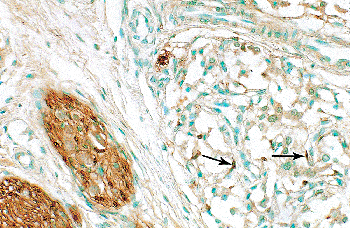 |
Figure 48.10 Organ of Zuckerkandl and adjacent sympathetic ganglion (same specimen as in Figures 48.20,48.21,48.22,48.23), stained for S-100 protein. Immunoreactivity for this antigen is typically localized in both nuclei and cytoplasm. Scattered sustentacular cells are stained in the organ of Zuckerkandl (right, arrows), where they tend to be located at the periphery of cell nests. Schwann cells are stained in the ganglion (left). |
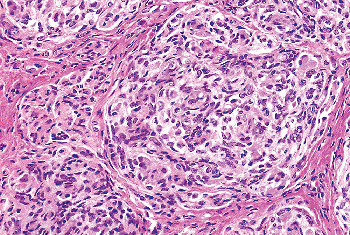 |
Figure 48.11 Section of carotid body from a 6-day-old infant demonstrating a characteristically more heterogeneous cell population than in Figure 48.9. Small nests of chief cells are highlighted by surrounding sustentacular cells and other cell types. |
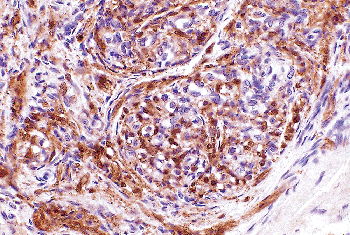 |
Figure 48.12 Lobule of a carotid body from a 16-day-old infant stained for S-100 protein. In contrast to the relatively sparse S-100 positive cells in the organ of Zuckerkandl (see Figure 48.10), there are numerous stained sustentacular cells within the lobule, accentuating the Zellballen, and numerous stained Schwann cells both within and adjacent to the lobule, as diagrammed in Figure 48.17. |
Ultrastructure
At the ultrastructural level, paraganglionic neuroendocrine cells are characterized by numerous membrane-bound granules or dense-core vesicles approximately 60 to 400 nm in greatest dimension. They sometimes also contain small synaptic-like vesicles that may accumulate in clusters near the plasma membrane (73). Neuroendocrine secretory granules may vary in size, shape, and electron density, reflecting differences in the secretory products stored, the functional state of individual cells, and fixation conditions. In the rodent adrenal medulla, where epinephrine and norepinephrine are mostly stored in separate cells, fixation in glutaraldehyde and postfixation in osmium tetroxide cause granules in norepinephrine cells to appear homogeneously electron dense, whereas those in epinephrine cells are lighter and finely particulate. The mechanism for the differentiation involves formation of an insoluble reaction product between glutaraldehyde and norepinephrine, which is subsequently
P.1221
darkened by osmium (1,74). Because epinephrine does not similarly react with glutaraldehyde, it diffuses out of the granules, leaving behind other granule constituents that are less osmiophilic. To be successful, this method requires adequate fixation of fresh tissue. Human adrenal medullary cells occasionally exhibit homogeneous populations of epinephrine or norepinephrine-type granules (Figure 48.16), but most cells have mixed granule populations (75) and synthesize both epinephrine and norepinephrine (76). The electron density of most granules in extra-adrenal paraganglia is comparable to that of norepinephrine-type granules in the adrenal.
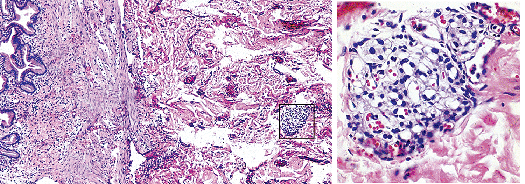 |
Figure 48.13 A microscopic paraganglion (small, oval, blue structure outlined in box) discovered as an incidental finding in the wall of the gallbladder of a 40-year-old woman. Right panel shows higher magnification of the paraganglion, illustrating prominent capillaries and admixed cell types. |
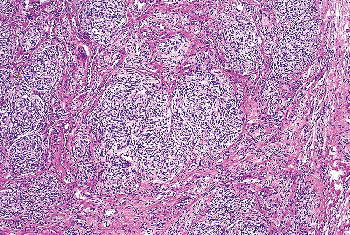 |
Figure 48.14 Carotid body from a 10-day-old infant, illustrating lobules separated by connective tissue septa. |
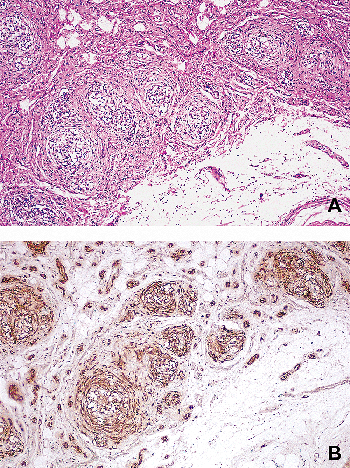 |
Figure 48.15 A. Carotid body from a 55-year-old woman with hypertension and emphysema. Lobules are separated by greater amounts of connective tissue than in Figure 48.14. In addition, there is a circumlobular proliferation of Schwann cells, demonstrable by staining for S-100 protein (B). The latter change has been reported by some investigators to be characteristic of lobular hyperplasia in patients with hypertension (56). |
The ultrastructural organization of paraganglia and the proportions of their constituent cell types vary in different sites, apparently to suit different physiological needs. Both sympathetic and parasympathetic paraganglia contain numerous small capillaries. In the former, portions of the surfaces of neuroendocrine cells closest to these vessels are usually separated from the capillary endothelium only by basal laminae and occasional collagen fibrils, suggesting that sympathetic paraganglia in most instances function as endocrine glands (61). In some locations, their secretory products appear to be provided for local use (9). In contrast, the neuroendocrine cells in parasympathetic paraganglia tend to be separated from the capillary lumina by sustentacular cells, pericytes, or both (Figures 48.17,48.18,48.19). It therefore appears that a major role of their
P.1222
secretory products is to act directly on sensory parasympathetic nerve endings rather than to enter circulating blood (62,73,77,78).
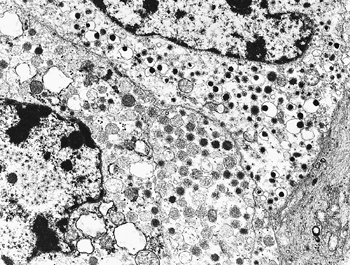 |
Figure 48.16 Electron micrograph of normal human adrenal medulla fixed in glutaraldehyde and postfixed in osmium tetroxide. Portions of cells at left contain predominantly light, finely particulate epinephrine-type granules, whereas cells at right contain predominantly dark, homogeneously electron-dense norepinephrine-type granules. The eccentric location of the granule cores within their surrounding membranes is a fixation artefact most commonly observed with granules of the latter type (original magnification 9,677). (Reprinted with permission from: Tischler AS, The adrenal medulla and extra-adrenal paraganglia. In: Kovacs K, Asa SL, eds. Functional Endocrine Pathology. Cambridge, MA: Blackwell; 1990. ) |
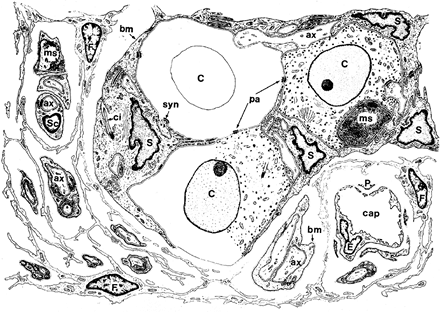 |
Figure 48.17 Diagram of the architecture of the human carotid body at the periphery of a lobule. Chief cells (C) in a small nest are insulated from the lumen of a nearby capillary (cap) by sustentacular cells (S), fibroblasts (F), and pericytes (P) and form synapses (syn) with parasympathetic axons (ax). They are also joined to each other by simple puncta adherentia type junctions (pa). Axons surrounded by Schwann cells (Sc) are present at the periphery of the lobule. Other illustrated structures are basement membrane (bm), endothelial cells (E), cilia (ci), and mitochondrion-rich axonal dilations termed mitochondrial sacs (ms). (Reprinted with permission from: B ck P, Stockinger L, Vyslonzil E. The fine structure of the human carotid body [article in German]. Z Zellforsch Mikrosk Anat 1970;105:543 568. ) |
The relationships between individual neuroendocrine cells and nerve endings in paraganglia can be defined as presynaptic, postsynaptic, or reciprocally synaptic, based on the locations of synaptic membrane densities and vesicle accumulations. In the adrenal medulla the chromaffin cells are postsynaptic, consistent with their principal role of secreting hormones in response to neural stimulation. In contrast, numerous reciprocal synapses involving nerve endings and chief cells of the carotid body are consistent with the carotid body's chemosensory functions.
Despite the above generalizations, there is some overlap in the functional organization of sympathetic and parasympathetic paraganglia. This is especially apparent for SIF cells, at least in rodents, where they have been extensively studied. SIF cells are usually related to blood vessels and nerve endings comparably to other sympathetic paraganglionic cells. In some ganglia, however, they are insulated from the capillary lumina (11,12). Generally, they receive preganglionic sympathetic synapses, but in a few locations some may apparently also provide synapses to sympathetic neurons, suggesting a role as interneurons. Some also may be involved in reciprocal synapses with their preganglionic axons, suggesting chemoreceptor functions (79). Different SIF cells within a single small cluster can have different synaptic relationships, and a single process from one SIF cell can both synapse on a neuron and be in direct contact with a capillary basal lamina (11).
P.1223
It is important to note that two morphologically distinct types of SIF cells have been described in rodents, accounting in part for this functional diversity. Type I SIF cells, which have ultrastructural features intermediate between neuroendocrine cells and neurons and are possibly interneurons, have not been identified in human ganglia. Type II SIF cells which are the only identified human SIF cell, resemble chromaffin cells or chief cells in sympathetic paraganglia (2).
 |
Figure 48.18 Electron micrograph of human carotid body from an area similar to that illustrated in Figure 48.17. S, sustentacular cell; cap, capillary; ax, axon (original magnification 8,000). (Adapted with permission from: B ck P, Stockinger L, Vyslonzil E. The fine structure of the human carotid body [article in German]. Z Zellforsch Mikrosk Anat 1970;105:543 568. ) |
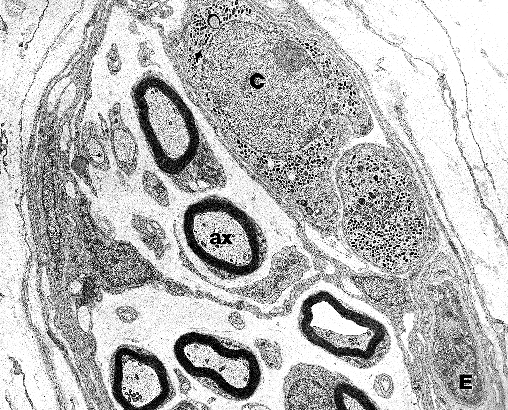 |
Figure 48.19 Electron micrograph of two chief cells enclosed within the perineurium of a small myelinated nerve in the vicinity of a human carotid body. This configuration has been described for intravagal paraganglia (53). As in the carotid body (see Figures 48.17 and 48.18), the chief cells are separated from the lumen of a nearby capillary (original magnification 5,400). C, chief cells; E, endothelial cell; ax, axons. (Courtesy of Professor P. B ck.) |
Function
Physiological Roles
Paraganglia release secretory products in response to neural or chemical stimuli. Those products may be used for endocrine, paracrine, neurotransmitter, or neuromodulatory functions, depending on their anatomic context. Although their secretory products are similar and there is evidence of some functional overlap, sympathetic and parasympathetic paraganglia generally appear to differ in the major types of stimuli to which they respond. Responses to different types of stimuli also may delineate subsets of paraganglia within the sympathetic and parasympathetic groups.
The adult adrenal medulla responds principally to signals derived from neurons via trans-synaptic stimulation. Various physiological stressors reflexly evoke discharges of splanchnic nerve endings that synapse on chromaffin cells, causing release of secretory granules by Ca2+-mediated exocytosis. This secretory response is accompanied by ancillary effects including activation of protooncogenes (80), activation and induction of enzymes involved in replenishing granule constituents (81), and possibly stimulation of chromaffin cell proliferation (82). Cellular responses to neurally derived signals may be modulated by chemical signals, including corticosteroids and other hormones (81), growth factors (83), and secreted chromogranin fragments (84). Recent studies of the rat adrenal medulla suggest that neurally derived signals may increase the expression of receptors that regulate chromaffin cell function, including the receptor tyrosine kinase RET. The finding that RET expression is not static may help to resolve the conundrum of how that molecule, which is expressed at very low levels in the adult adrenal, contributes to the development of adrenal medullary hyperplasia and pheochromocytoma in MEN2 syndromes (85).
The sparse innervation of the extra-adrenal sympathetic paraganglia (61) suggests that they respond principally to chemical signals, and one possible signal is hypoxemia. It has been suggested that the organ of Zuckerkandl in rabbits and humans secretes catecholamines in response to hypoxemia during development (86,87). In other species, chemoreceptive functions have also been postulated for certain SIF cells (78,87,88), and for the immature adrenal medulla before the establishment of innervation (90).
Chemoreception is best established as a function of parasympathetic paraganglia. It was first shown in the 1930s that the carotid bodies and aortic paraganglia function as portions of reflex loops involving the central nervous system, whereby low pO2, low pH, and high pCO2 stimulate breathing (4). However, it was long debated whether the neuroendocrine cells in the carotid body are the primary receptor elements or whether their function is to modulate chemoreceptor properties intrinsic to the
P.1224
sensory nerve endings. Electrophysiological studies of the mechanism of chemoreception have shown that the three major chemosensory stimuli depolarize dissociated carotid body chief cells. This leads to influx of calcium through voltage-gated calcium channels and to calcium-dependent release of secretory products to stimulate sensory nerve endings (10,91). Chemoreceptor reflexes have been postulated for other parasympathetic paraganglia on the basis of their similarities to the carotid body (28,92), but the nature and importance of such reflexes in vivo have not been defined. It may be of interest in this regard that patients who have had their carotid bodies removed exhibit impaired ventilatory reflexes (93), and that carotid body hyperplasia occurs in association with life at high altitude (54), chronic obstructive pulmonary disease, restrictive pulmonary disease, cystic fibrosis, and cyanotic congenital heart disease (52,53,55,56,57,58). In contrast, vagal paraganglia only sometimes increase in number or size (55). A tenfold increase in the prevalence of carotid body paragangliomas is reported at high altitudes (94), but this association has not been made for paragangliomas at other sites.
Secretory Products
Although studies using the chromaffin reaction suggested that catecholamines were produced by sympathetic not parasympathetic paraganglia (4), more sensitive methods now available indicate that they are produced by paraganglia of both classes. Those methods include immunocytochemistry to demonstrate both catecholamines themselves and their biosynthetic enzymes (76,95,96), as well as older fluorescence techniques to demonstrate catecholamine stores (97) (see Special Procedures ). Most of the body's epinephrine production is in the adrenal medulla, where the epinephrine-to-norepinephrine ratio is approximately 4:1 (98). In contrast, over 90% of the catecholamine content of extra-adrenal sympathetic paraganglia is norepinephrine (20). Parasympathetic paraganglia produce almost no epinephrine but may produce significant quantities of dopamine (99). Serotonin has been reported in addition to catecholamines in some human paraganglia (100), but it is not clear in some studies whether the presence of serotonin is due to synthesis or uptake (101).
In addition to producing catecholamines, both sympathetic and parasympathetic paraganglia synthesize regulatory peptides, the most prevalent of which are enkephalins (76,102,103,104,105). Regulatory peptides and amines usually coexist in the same cells and in the same secretory granules (105). The granules also contain granin proteins (103,106,107), adenine nucleotides, peptide-cleaving and amidating enzymes, dopamine beta-hydroxylase, and numerous other constituents of both known and unknown function (108). Peptide growth factors that might exert autocrine, paracrine, and neurotropic effects also may be present (108,109). Together these granule constituents comprise a secretory cocktail, the composition of which can be varied in different physiological and pathological states (81,108).
Gender Differences
Significant gender differences in the histology of paraganglia have not been reported. However, there is some evidence for functional differences. For example, women in general appear to have slightly increased susceptibility to carotid body paragangliomas. This difference is accentuated by life at high altitude, where the tumors have a female-to-male ratio of approximately 8:1 (110).
Aging Changes
Aging changes described in human paraganglia are limited to the topographic and involutional changes described in the sections on Distribution of Paraganglia, Gross Features and Organ Weights, and Lobular Architecture of the Carotid Body. Subtle histochemical changes have been described in the composition of adrenal chromaffin granules of rats (111) and also might occur in other paraganglia. Hypertrophy or hyperplasia of extra-adrenal paraganglia also occurs in aging rats (112).
Special Procedures
Immunohistochemistry
The study of normal and pathologic paraganglia has been greatly facilitated by recent advances in immunohistochemistry. Antibodies that are now commercially available permit identification and functional characterization of specific paraganglionic cell types in sections of formalin-fixed, paraffin-embedded tissue. In addition, the advent of microwave antigen retrieval (113) has both improved the quality of immunohistochemical staining and eliminated some of the variability previously caused by prolonged fixation. Highly sensitive, polymer-based reporter systems have both increased the sensitivity of immunohistochemical staining and eliminated artefact due to endogenous biotin (114). For most purposes, immunohistochemistry can now replace previously useful but more cumbersome or less specific techniques such as electron microscopy, catecholamine fluorescence, or silver stains.
Paraganglia express a plethora of markers shared to varying degrees with other neural and endocrine tissues. A partial categorization includes amines, regulatory peptides, granins and other constituents of the secretory granule matrix, secretory granule membrane and cell membrane
P.1225
components, and cytoskeletal proteins. Proteins known as SNAP s and SNARE s (SNAP receptors) that are involved in docking of secretory granules at the cell membrane in preparation for exocytosis comprise an important new class of markers. Those proteins include synaptobrevin, synaptotagmin, syntaxin, and SNAP-25 (115).
For pathologists, the major current applications of immunohistochemistry to the paraganglionic system are the diagnosis and functional characterization of paraganglionic tumors. Potential future applications include identification of markers that may be applicable to targeted therapy, such as specific somatostatin receptor subtypes (116), or profiling of tumors for clusters of markers associated with specific tumor syndromes or with malignancy (15) (see Clinicopathologic Perspective ) (76,103,117).
For diagnostic purposes, care must be taken to select from the large number of available markers those that are the most specific. For example, immunoreactivity for synaptophysin, a secretory vesicle membrane protein, is characteristically present in paraganglia but also reported in adrenal cortex (118,119). Similarly, certain SNAP and SNARE proteins are present in normal lymphoid cells (120,121). Reagents that have been particularly valuable in histopathology of paraganglia are antibodies against chromogranin A (CgA), catecholamine biosynthetic enzymes, and S-100 protein.
CgA is an acidic protein that constitutes more than half the weight of many types of neuroendocrine secretory granule. It appears to be present in most or all paraganglionic neuroendocrine cells and is therefore a useful generic marker that can, in most instances, serve to establish the neuroendocrine nature of particular cells or tissues in the paraganglionic system (122,123) (Figures 48.20,48.21,48.22,48.23,48.24,48.25,48.26,48.27). Because it is concentrated mostly in secretory granules, it may fail to stain cells that are degranulated due to low rates of synthesis, high rates of turnover, or low storage capacity. In sympathetic ganglia, it can be used to conveniently discriminate SIF cells from principal sympathetic neurons, which produce CgA but have few perikaryal secretory granules (124) (Figures 48.21, 48.22, and 48.24). CgA was the first described member of the granin family of proteins, which now includes seven members (CgA and B, secretogranin II and III, 7B2, NESP55, and VGF) (106,107). These proteins are differentially expressed in neuroendocrine tissues of different species. Although most are present in the adrenal medulla, their distributions in other paraganglia are incompletely mapped (107). Their roles include sorting of proteins to the regulated secretory pathway and directing secretory granule biogenesis. In addition, they serve as multifunctional prohormones, giving rise to cleavage fragments that exert a variety of autocrine, paracrine, and systemic effects.
 |
Figure 48.20 Transverse section through the aorta of a mid-trimester human fetus (same fetus as in Figure 48.25) at the level of the inferior mesenteric artery, demonstrating organ of Zuckerkandl and adjacent sympathetic ganglion, related as diagrammed in Figure 48.2. |
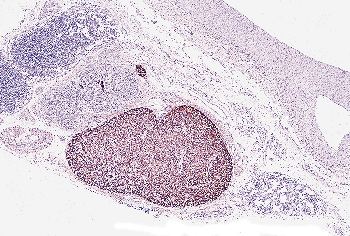 |
Figure 48.21 Section adjacent to that shown in Figure 48.20, stained for CgA. Staining is intense in the organ of Zuckerkandl and in small nests of neuroendocrine cells within and adjacent to the ganglion, but not in sympathetic neurons. |
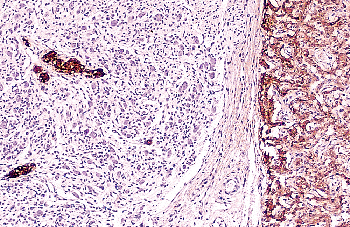 |
Figure 48.22 Higher magnification of central area of section shown in Figure 48.21. Organ of Zuckerkandl is on right, ganglion on left. |
P.1226
 |
Figure 48.23 Section adjacent to that shown in Figure 48.22, stained for TH. Intense immunoreactivity is present in both sympathetic neurons and paraganglionic neuroendocrine cells. |
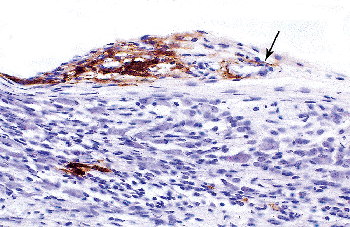 |
Figure 48.24 Sympathetic ganglion from the paravertebral trunk of a mid-trimester human fetus (same fetus as in Figures 48.20,48.21,48.22,48.23), stained for CgA. Neuroendocrine cells are identified both within and adjacent to the ganglion. CgA-positive processes, which might be derived from either neurons or neuroendocrine cells, surround a small blood vessel (arrow). |
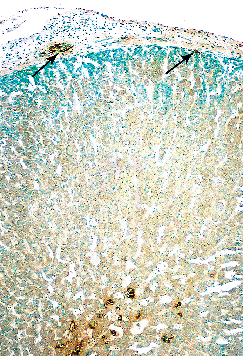 |
Figure 48.25 Adrenal gland from a mid-trimester human fetus (same fetus as in Figures 48.20,48.21,48.22,48.23), stained for CgA. The medulla (bottom) contains only scattered positive cells, in contrast to the organ of Zuckerkandl (Figure 48.21). Extra-adrenal (left arrow) and subcapsular (right arrow) paraganglionic cells are also identified by their immunoreactivity. |
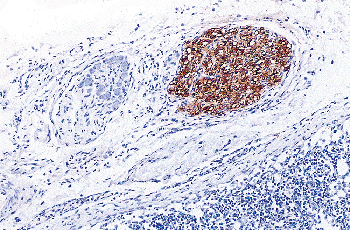 |
Figure 48.26 A small retroperitoneal paraganglion similar to that in Figure 48.13, incidentally removed along with adjacent ganglion and lymph node from a 5-month-old infant during resection of a Wilms' tumor. Soaking the coverslip off a routine H&E stained histologic section and restaining for CgA confirmed the identity of the paraganglion. The stability and abundance of this antigen make it particularly suitable for such procedures. |
 |
Figure 48.27 Lobule of a carotid body stained for CgA, demonstrating nests of immunoreactive chief cells surrounded by unstained cells of other types. |
P.1227
Perhaps the most important advance in decades from the standpoint of surgical pathology of the paraganglia is the availability of antibodies against the catecholamine-synthesizing enzymes tyrosine hydroxylase (TH), dopamine beta-hydroxylase (DBH), and phenylethanolamine-N-methyltransferase (PNMT). With these reagents, it is now usually possible to infer from a paraffin section not only whether a tumor was catecholamine producing, but also what catecholamines were produced. The need for fluorescence methods that directly detect catecholamine stores but require fresh tissue is therefore, in most instances, eliminated. Tyrosine hydroxylase (TH) is the rate-limiting enzyme in catecholamine synthesis and is therefore found in all catecholamine-producing cells (Figures 48.23 and 48.28), whereas dopamine -hydroxylase (DBH) is found only in cells that produce norepinephrine, and PNMT is found only in cells that can convert norepinephrine to epinephrine. This immunocytochemical approach provides a cellular correlate to biochemical data by demonstrating that only rarely do extra-adrenal paraganglionic cells stain for PNMT (95), in contrast to the adrenal medulla where the great majority of cells are stained (76) (Figures 48.29 and 48.30). It also has been useful in demonstrating catecholamine-synthesizing ability in pheochromocytomas and extra-adrenal paragangliomas (96,125). Because TH and PNMT are cytosolic enzymes (108), staining is not dependent on storage of secretory granules. Sympathetic neurons, for example, stain strongly for TH (Figure 48.23), in contrast to their weak or absent staining for CgA (Figures 48.21, 48.22, 48.24, and 48.26). In contrast to chromogranins, which are present in many types of neuroendocrine cells, catecholamine biosynthetic enzymes in adult humans are normally present only in paraganglia and neurons (95). In addition to their biosynthetic enzymes, catecholamines themselves may be localized by immunohistochemistry. However, the presence of catecholamines without biosynthetic enzymes under some circumstances (96) suggests that synthesis cannot be distinguished from uptake by this approach.
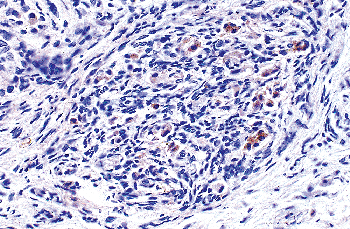 |
Figure 48.28 Lobule of a carotid body stained for TH. The catecholamine-synthesizing ability of chief cells is inferred by positive staining of chief cell nests, which are surrounded by unstained cells of other types. |
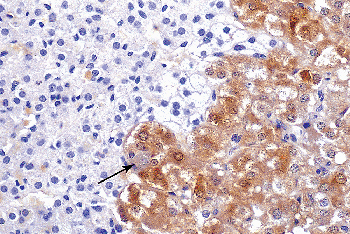 |
Figure 48.29 Adult adrenal gland stained for PNMT. The ability of almost all neuroendocrine cells in the adrenal medulla to synthesize epinephrine is inferred from their positive staining. Occasional cells are unstained (arrow) as previously reported (76) and as suggested by the electron micrograph in Figure 48.16. |
S-100 protein was initially described as a calcium-binding dimer consisting of alpha-alpha, alpha-beta, or beta-beta chains and was initially believed to be specific for central and peripheral nervous system glial cells. Subsequent studies showed a wider distribution of immunoreactivity (126). Immunostaining for S-100 nevertheless provides a useful marker in appropriate contexts. Because of their nondescript cytologic characteristics, the sustentacular cells in paraganglia are difficult to identify with certainty in sections stained with hematoxylin and eosin. The intense nuclear
P.1228
immunoreactivity of these cells for S-100 permits them to be identified in sympathetic and parasympathetic paraganglia (Figures 48.10 and 48.12). Interestingly, they also may be identified in paragangliomas (71,72), a finding that might reflect either ingrowth from nearby normal tissue or bidirectional differentiation. Sustentacular cells must be distinguished from Langerhans cells and interdigitating reticulum cells of the immune system, which also express S-100. Both sustentacular cells and Schwann cells contain predominantly the beta subunit of S-100 (127). The S-100 protein family has now expanded beyond the original alpha and beta subunits to include at least 17 members postulated to play a variety of roles in different cell types (128).
 |
Figure 48.30 Organ of Zuckerkandl (same specimen as in Figures 48.20,48.21,48.22,48.23) stained for PNMT. Although all the neuroendocrine cells stain for TH and can produce catecholamines (Figure 48.23), only rare cells (arrow) contain immunoreactive PNMT. This finding is consistent with the limited ability of extra-adrenal paraganglia to synthesize epinephrine, the final step in the catecholamine biosynthetic pathway. |
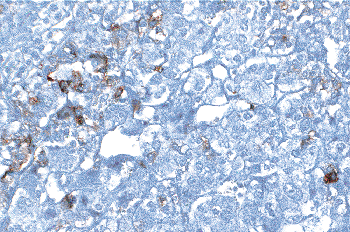 |
Figure 48.31 Adult adrenal gland stained for somatostatin, illustrating strongly immunoreactive cells scattered among cells with no detectable immunoreactivity. Immunohistochemical staining of paraganglionic neuroendocrine cells for regulatory peptides can suggest functional heterogeneity despite the fact that all of the cells produce catecholamines. |
Immunohistochemical studies might help to reveal subtle expressions of functional heterogeneity in normal paraganglia that could contribute to understanding of syndrome-associated phenotypes. Examples might include the absence of epinephrine-synthesizing ability or the expression of particular regulatory peptides in small numbers of human chromaffin cells (76) (Figures 48.29,48.30,48.31). Evidence of differential innervation might also provide clues to differential function (103,117).
Immunohistochemical Artifacts
Important artifacts that must be borne in mind in immunohistochemical studies of paraganglia are the nonspecific interactions of some, but not all, antibodies with the secretory granules of mast cells (129,130) and of certain neuroendocrine cells (131). These artifacts may be particularly troublesome because, due to their inconstancy, negative controls consisting of irrelevant antibodies or normal sera are not adequate. The mast cell artifact has undoubtedly resulted in erroneous published reports of neuroendocrine secretory products in nonendocrine tissues, and also could produce incorrect results in studies of paraganglia because of their sometimes high mast cell content (67). The mechanism of the mast cell artifact is not known (130), but in some cases the staining may be eliminated by dilution in the presence of normal serum proteins (129). Nonspecific binding of immunoglobulins to neuroendocrine secretory granules appears to result from ionic interactions and may be reduced by high concentrations of salt in the buffer (131). A buffer containing 0.5 mol/L NaCl should not interfere with specific high-affinity antigen antibody interactions and, in many instances, may be used routinely.
Other artifacts that are not specific to neuroendocrine cells may also be encountered in studies of paraganglia. In immunohistochemical protocols that employ a biotin bridge, such as the widely utilized ABC technique, artefactual staining may result from the presence of endogenous biotin. This problem may be exacerbated by heat-based antigen retrieval, which can unmask endogenous biotin in addition to specific antigens (132). Commercially available biotin blocking kits offer some remedy, but a preferable solution may be to discontinue the use of biotin-based systems and switch to newer methods that employ secondary antibodies conjugated to polymer-bound reporter enzymes (114). Various types of artifactual staining with less clear mechanisms are also sometimes encountered. In the adrenal gland, for example, some antibodies inexplicably produce spurious staining in the adrenal cortex (114). This particularly tends to occur in the inner portion of the cortex, and might therefore result from nonspecific interactions of some antibodies with lipochrome pigments. Cells that are rich in mitochondria occasionally also show weak nonspecific staining. In addition to spurious staining caused by these and other artifacts, the possibility of actual immunological cross-reactivity of an antibody with different proteins must always be considered.
In general, immunohistochemical studies should be performed with optimally diluted antibodies and verified, when practical, with antibodies from more than one source. Ideally, adsorption controls and immunoblots should also be employed for validation, particularly in research studies or when new markers or antibodies are introduced. Controls consisting solely of primary antibody omission should not be considered adequate even for routine studies. Buffer composition, blocking proteins, and controls are now to some extent becoming standardized in automated staining procedures, but should still be optimized for each new antibody as discussed in many textbooks and reviews (133).
Other Special Procedures
Fluorescence methods for detection of catecholamines or other biogenic amines now have very little use in routine pathology. However, literature searches of PubMed or other databases continue to demonstrate the value of these techniques in occasional research applications.
P.1229
Catecholamines can be demonstrated in freeze dried or frozen sections or in touch preparations either by formaldehyde vapor (97,134) or glyoxylic acid induced (135) fluorescence. The glyoxylic acid method is usually preferable because it produces nondiffusing fluorophores.
Other research applications of histological techniques include the use of in situ hybridization to detect genetic abnormalities in paragangliomas (136,137,138) or to map the expression of specific mRNAs (139).
Differential Diagnosis
Paraganglia must be discriminated from normal but similar-appearing nonparaganglionic structures and from a variety of malignant tumors. The ampulloglomerular organ (140), glomus coccygeum, and glomera cutanea are thermoregulatory structures respectively located in the suboccipital and coccygeal regions and in the skin, resembling but unrelated to paraganglia. Lobules of fetal fat may at times appear reminiscent of paraganglia. All of these structures can be readily distinguished from paraganglia by their absence of staining for CgA, TH, or other neuroendocrine markers. Reports of paraganglia in anomalous locations (4) are also now amenable to immunohistochemical verification. Prostatic paraganglia may be misinterpreted as prostatic adenocarcinoma (141), bladder paraganglia may be confused with transitional cell carcinoma (142), and retroperitoneal paraganglia may be confused with metastatic clear cell carcinoma (143). The presence of mitoses, cytologic atypia, glandular or squamous differentiation, or stromal reaction point toward a diagnosis of tumor, and questionable cases can be readily resolved by immunohistochemistry.
More problematic are cases in which paraganglia or paragangliomas must be distinguished from other normal or neoplastic neuroendocrine tissues that express many of the same markers. Knowledge of the distribution and morphology of paraganglia is essential in these cases. In addition, the presence of tyrosine hydroxylase in paragangliomas or of other site-suggestive markers in other types of tumors, for example calcitonin in medullary thyroid carcinoma, may be helpful. Tumors showing glandular or squamous differentiation are almost certainly not paraganglionic.
In the adrenal gland, developmental neuroblastic nests (see Embryologic Changes ) must be distinguished from in situ neuroblastoma (42,43). Cortical invasion, mitoses, and necrosis are all characteristic of normal cells in this instance. Ikeda et al. (40) reported that the nuclei of normal adrenal medullary progenitors are smaller on average than those of neuroblastoma cells, and this might prove to be diagnostically useful. In view of the large potential effect of fixation on nuclear size, however, the problem is more likely to be resolved using molecular techniques (144).
Specimen Handling
For most purposes, normal and pathologic paraganglionic tissue may be evaluated histologically and immunohistochemically after routine formalin fixation and paraffin embedding (see Special Procedures ). In the age of heat-based antigen retrieval, under-fixation may create as many artefacts as the traditional problem of over-fixation. However, some antigens are still irretrievably damaged by excessive fixation. Fixation of thin tissue slices overnight is usually adequate. Electron microscopy, when necessary, is optimally performed after glutaraldehyde fixation and osmium postfixation (see Ultrastructure ). Catecholamines may be demonstrated in touch preparations or frozen sections using glyoxylic acid induced fluorescence (see Special Procedures ).
For biochemical analysis, catecholamines may be preserved by freezing small minced tissue fragments or tissue homogenates at 70 C in 0.4 mol/L perchloric acid in 1 mmol/L ethylene diamine tetra-acetic acid (145). Peptide hormones may be preserved by freezing in 1.0 mol/L acetic acid.
With burgeoning interest in molecular studies of paraganglia, it is increasingly necessary to preserve DNA, RNA, and protein samples. Tissue handling is particularly critical for RNA and protein preservation, and the traditional approach is rapid freezing and storage in liquid nitrogen. However, a number of solutions that are now commercially available provide comparable or superior preservation of both nucleic acids and protein for at least several weeks at room temperature for convenient handling and shipping. This approach may facilitate standardization of noncentralized specimen collection (146,147).
Acknowledgments
I thank Drs. Peter B ck, Ernest Lack, and James Powers for contributing illustrative material and Dr. Harold Kozakewich for contributing tissue blocks.
References
1. Coupland RE. The Natural History of the Chromaffin Cell. London: Longmans Green; 1965.
2. Coupland RE. The natural history of the chromaffin cell twenty-five years on the beginning. Arch Histol Cytol 1989; 52(supp l):331 341.
3. Carmichael SW. The history of the adrenal medulla. Rev Neurosci 1989;2:83 99.
4. Zak FG, Lawson W. The Paraganglionic Chemoreceptor System: Physiology, Pathology and Clinical Medicine. New York: Springer-Verlag; 1982.
5. Kohn A. Die paraganglien. Arch Mikr Anat 1903;62:263 365.
6. Pearse AG, Polak JM, Rost FW, Fontaine J, Le Lievre C, Le Douarin N. Demonstration of the neural crest origin of type I (APUD) cells in the avian carotid body, using a cytochemical marker system. Histochemie 1973;34:191 203.
P.1230
7. Le Douarin N. The Neural Crest. Cambridge, England: Cambridge University Press; 1982.
8. Hadjiconstantinou M, Potter PE, Neff NH. Trans-synaptic modulation via muscarinic receptors of serotonin-containing small intensely fluorescent cells of superior cervical ganglion. J Neurosci 1982;2:1836 1839.
9. Furness JB, Sobels G. The ultrastructure of paraganglia associated with the inferior mesenteric ganglia in the guinea-pig. Cell Tissue Res 1976;171:123 139.
10. Spicer Z, Millhorn DE. Oxygen sensing in neuroendocrine cells and other cell types: pheochromocytoma (PC12) cells as an experimental model. Endocr Pathol 2003;14:277 291.
11. Matthews MR. Synaptic and other relationships of small granule-containing cells (SIF cells) in sympathetic gangulia. In: Coupland RE, Fujita T, eds. Chromaffin, Enterochromaffin and Related Cells. Amsterdam: Elsevier; 1976;131 146.
12. Matthews MR. Ultrastructural studies relevant to the possible functions of small granule-containing cells in the rat superior cervical ganglion. Adv Biochem Psychopharmacol 1980;25:77 86.
13. Dannenberg H, Komminoth P, Dinjens WN, Speel EJ, de Krijger RR. Molecular genetic alterations in adrenal and extra-adrenal pheochromocytomas and paragangliomas. Endocr Pathol 2003; 14:329 350.
14. Eisenhofer G, Bornstein SR, Brouwers FM, et al. Malignant pheochromocytoma: current status and initiatives for future progress. Endocr Relat Cancer 2004;11:423 436.
15. Eisenhofer G, Huynh TT, Pacak K, et al. Distinct gene expression profiles in norepinephrine- and epinephrine-producing hereditary and sporadic pheochromocytomas: activation of hypoxia-driven angiogenic pathways in von Hippel-Lindau syndrome. Endocr Relat Cancer 2004;11:897 911.
16. Eisenhofer G, Goldstein DS, Kopin IJ, Crout JR. Pheochromocytoma: rediscovery as a catecholamine-metabolizing tumor. Endocr Pathol 2003;14:193 212.
17. Hervonen A, Partanen S, Vaalasti A, Partanen M, Kanerva L, Alho H. The distribution and endocrine nature of the abdominal paraganglia of adult man. Am J Anat 1978;153:563 572.
18. Baljet B, Boekelaar AB, Groen GJ. Retroperitoneal paraganglia and the peripheral autonomic nervous system in the human fetus. Acta Morphol Neerl Scand 1985;23:137 149.
19. Hervonen A, Vaalasti A, Partanen M, Kanerva L, Hervonen H. Effects of ageing on the histochemically demonstrable catecholamines and acetylcholinesterase of human sympathetic ganglia. J Neurocytol 1978;7:11 23.
20. Coupland RE. The development and fate of catecholamine-secreting endocrine cells. In: Parvez H, Parvez S, eds. Biogenic Amines in Development. Amsterdam: Elsevier/North-Holland Biomedical Press; 1980;3 28.
21. Zuckerkandl E. Ueber nebenorgane des sympathicus im Retroperitonaealraum des menschen. Verh Anat Ges 1901;15:85 107.
22. Ober WB. Emil Zuckerkandl and his delightful little organ. Pathol Annu 1983;18(pt 1):103 119.
23. Lack EE, Cubilla AL, Woodruff JM, Lieberman PH. Extra-adrenal paragangliomas of the retroperitoneum: a clinicopathologic study of 12 tumors. Am J Surg Pathol 1980;4:109 120.
24. Helen P, Alho H, Hervonen A. Ultrastructure and histochemistry of human SIF cells and paraganglia. Adv Biochem Psychopharmacol 1980;25:149 152.
25. Kohn A. Die chromaffinen Zellen des sympathicus. Anat Anz 1898;15:399 400.
26. Glenner GG, Grimley PM. Tumors of the extraadrenal paraganglion system (including chemoreceptors). In: Atlas of Tumor Pathology. 2nd series, fascicle 9. Washington, DC: Armed Forces Institute of Pathology; 1974.
27. Guild SR. The glomus jugulare, a nonchromaffin paraganglion, in man. Ann Otol Rhinol Laryngol 1953;62:1045 1071; concld.
28. Dahlqvist A, Carlsoo B, Hellstrom S. Paraganglia of the human recurrent laryngeal nerve. Am J Otolaryngol 1986;7:366 369.
29. Grillo MA, Jacobs L, Comroe JH Jr. A combined fluorescence histochemical and electron microscopic method for studying special monoamine-containing cells (SIF cells). J Comp Neurol 1974;153:1 14.
30. Manger WM, Gifford RW. Clinical and Experimental Pheochromocytoma. 2nd ed. Cambridge, MA: Blackwell Science; 1996.
31. Plenat F, Leroux P, Floquet J, Floquet A. Intra and juxtavagal paraganglia: a topographical, histochemical, and ultrastructural study in the human. Anat Rec 1988;221:743 753.
32. Goormagtigh N. On the existence of abdominal vagal paraganglia in the adult mouse. J Anat 1936;71:77 90.
33. Kuo T, Anderson CB, Rosai J. Normal paraganglia in the human gallbladder. Arch Pathol 1974;97:46 47.
34. Cooper MJ, Hutchins GM, Israel MA. Histogenesis of the human adrenal medulla. An evaluation of the ontogeny of chromaffin and nonchromaffin lineages. Am J Pathol 1990;137:605 615.
35. Molenaar WM, Lee VM, Trojanowski JQ. Early fetal acquisition of the chromaffin and neuronal immunophenotype by human adrenal medullary cells. An immunohistological study using monoclonal antibodies to chromogranin A, synaptophysin, tyrosine hydroxylase, and neuronal cytoskeletal proteins. Exp Neurol 1990;108:1 9.
36. Korkala O, Hervonen A. Origin and development of the catecholamine-storing cells of the human fetal carotid body. Histochemie 1973;37:287 297.
37. Kjaergaard J. Anatomy of the Carotid Glomerus and Carotid Glomus-like Bodies (Non-chromaffin Paraganglia). Copenhagen: FADL's Forlag; 1973.
38. Zuckerkandl E. The development of the chromaffin organs and of the suprarenal glands. In: Keibel F, Mall FP, eds. Manual of Human Embryology. Philadelphia: JB Lippincott; 1912;157 179.
39. Kuntz A. The development of the sympathetic nervous system in man. J Comp Neurol 1920;32:173 229.
40. Ikeda Y, Lister J, Bouton JM, Buyukpamukcu M. Congenital neuroblastoma, neuroblastoma in situ, and the normal fetal development of the adrenal. J Pediatr Surg 1981;16(suppl 1):636 644.
41. Willier BH. A study of the origin and differentiation of the suprarenal glandin the chick embryo by chorio-allantoic grafting. Phys Zool 1930;3:201 225.
42. Turkel SB, Itabashi HH. The natural history of neuroblastic cells in the fetal adrenal gland. Am J Pathol 1974;76:225 244.
43. Beckwith JB, Perrin EV. In situ neuroblastomas: a contribution to the natural history of neural crest tumors. Am J Pathol 1963;43:1089 1104.
44. Garcia I, Martinou I, Tsujimoto Y, Martinou JC. Prevention of programmed cell death of sympathetic neurons by the bcl-2 proto-oncogene. Science 1992;258:302 304.
45. Vogel KS. Development of trophic interactions in the vertebrate peripheral nervous system. Mol Neurobiol 1993;7:363 382.
46. Tischler AS, DeLellis RA, Biales B, Nunnemacher G, Carabba V, Wolfe HJ. Nerve growth factor-induced neurite outgrowth from normal human chromaffin cells. Lab Invest 1980;43:399 409.
47. Anderson DJ. Cellular neoteny : a possible developmental basis for chromaffin cell plasticity. Trends Genet 1989;5:174 178.
48. Gold R, Schmied M, Giegerich G, et al. Differentiation between cellular apoptosis and necrosis by the combined use of in situ tailing and nick translation techniques. Lab Invest 1994;71:219 225.
49. DeLellis RA, Wolfe HJ, Gagel RF, et al. Adrenal medullary hyperplasia. A morphometric analysis in patients with familial medullary thyroid carcinoma. Am J Pathol 1976;83:177 196.
50. Carney JA, Sizemore GW, Sheps SG. Adrenal medullary disease in multiple endocrine neoplasia, type 2: pheochromocytoma and its precursors. Am J Clin Pathol 1976;66:279 290.
51. Kreiner E. Weight and shape of the human adrenal medulla in various age groups. Virchows Arch A Pathol Anat Histol 1982;397:7 15.
52. Lack EE. Carotid body hypertrophy in patients with cystic fibrosis and cyanotic congenital heart disease. Hum Pathol 1977;8:39 51.
53. Lack EE. Hyperplasia of vagal and carotid body paraganglia in patients with chronic hypoxemia. Am J Pathol 1978;91:497 516.
54. Arias-Stella J, Valcarcel J. Chief cell hyperplasia in the human carotid body at high altitudes; physiologic and pathologic significance. Hum Pathol 1976;7:361 373.
P.1231
55. Lack EE, Perez-Atayde AR, Young JB. Carotid body hyperplasia in cystic fibrosis and cyanotic heart disease. A combined morphometric, ultrastructural, and biochemical study. Am J Pathol 1985;119:301 314.
56. Fitch R, Smith P, Heath D. Nerve axons in carotid body hyperplasia. A quantitative study. Arch Pathol Lab Med 1985;109:234 237.
57. Smith P, Jago R, Heath D. Anatomical variation and quantitative histology of the normal and enlarged carotid body. J Pathol 1982;137:287 304.
58. Heath D, Smith P, Jago R. Hyperplasia of the carotid body. J Pathol 1982;138:115 127.
59. McDonald DM, Blewett RW. Location and size of carotid body-like organs (paraganglia) revealed in rats by the permeability of blood vessels to Evans blue dye. J Neurocytol 1981;10:607 643.
60. Parker TL, Kesse WK, Mohamed AA, Afework M. The innervation of the mammalian adrenal gland. J Anat 1993;183(pt 2):265 276.
61. Hervonen A. Development of catecholamine-storing cells in human fetal paraganglia and adrenal medulla. A histochemical and electron microscopical study. Acta Physiol Scand Suppl 1971;368:1 94.
62. McDonald DM, Mitchell RA. The innervation of glomus cells, ganglion cells and blood vessels in the rat carotid body: a quantitative ultrastructural analysis. J Neurocytol 1975;4:177 230.
63. Eyzaguirre C, Fidone SJ. Transduction mechanisms in carotid body: glomus cells, putative neurotransmitters, and nerve endings. Am J Physiol 1980;239:C135 C152.
64. Kummer W, Habeck JO. Light and electronmicroscopical immunohistochemical investigation of the innervation of the human carotid body. Adv Exp Med Biol 1993;337:67 71.
65. Kusakabe T, Hirakawa H, Oikawa S, et al. Morphological changes in the rat carotid body 1, 2, 4, and 8 weeks after the termination of chronically hypocapnic hypoxia. Histol Histopathol 2004;19:1133 1140.
66. Holgert H, Dagerlind A, Hokfelt T. Immunohistochemical characterization of the peptidergic innervation of the rat adrenal gland. Horm Metab Res 1998;30:315 322.
67. Kraus R, Bezdicek P. The incidence of mastocytes in paraganglia. Folia Morphol (Praha) 1988;36:211 213.
68. Mirsky R, Jessen KR. The biology of non-myelin-forming Schwann cells. Ann N Y Acad Sci 1986;486:132 146.
69. Kondo H, Iwanaga T, Nakajima T. Immunocytochemical study on the localization of neuron-specific enolase and S-100 protein in the carotid body of rats. Cell Tissue Res 1982;227:291 295.
70. Habeck JO, Kummer W. Neuronal and neuroendocrine markers in the human carotid body in health and disease. Adv Exp Med Biol 1993;337:31 35.
71. Lauriola L, Maggiano N, Sentinelli S, Michetti F, Cocchia D. Satellite cells in the normal human adrenal gland and in pheochromocytomas. An immunohistochemical study. Virchows Arch B Cell Pathol Incl Mol Pathol 1985;49:13 21.
72. Lloyd RV, Blaivas M, Wilson BS. Distribution of chromogranin and S100 protein in normal and abnormal adrenal medullary tissues. Arch Pathol Lab Med 1985;109:633 635.
73. Verna A. Ultrastructure of the carotid body in the mammals. Int Rev Cytol 1979;60:271 330.
74. Coupland RE, Hopwood D. The mechanism of the differential staining reaction for adrenaline- and noreadrenaline-storing granules in tissues fixed in glutaraldehyde. J Anat 1966;100(pt 2):227 243.
75. Brown WJ, Barajas L, Latta H. The ultrastructure of the human adrenal medulla: with comparative studies of white rat. Anat Rec 1971;169:173 183.
76. Lundberg JM, Hamberger B, Schultzberg M, et al. Enkephalin- and somatostatin-like immunoreactivities in human adrenal medulla and pheochromocytoma. Proc Natl Acad Sci U S A 1979;76:4079 4083.
77. B ck P, Stockinger L, Vyslonzil E. The fine structure of the human carotid body [article in German]. Z Zellforsch Mikrosk Anat 1970;105:543 568.
78. Hervonen A, Korkala O. Fine structure of the carotid body of the midterm human fetus. Z Anat Entwicklungsgesch 1972;138:135 144.
79. Kondo H. Is the SIF cell truly an interneuron in the superior cervical ganglion? Adv Biochem Psychopharmacol 1980;25:103 109.
80. Greenberg ME, Ziff EB, Greene LA. Stimulation of neuronal acetylcholine receptors induces rapid gene transcription. Science 1986;234:80 83.
81. Sietzen M, Schober M, Fischer-Colbrie R, Scherman D, Sperk G, Winkler H. Rat adrenal medulla: levels of chromogranins, enkephalins, dopamine beta-hydroxylase and of the amine transporter are changed by nervous activity and hypophysectomy. Neuroscience 1987;22:131 139.
82. Tischler AS, DeLellis RA, Nunnemacher G, Wolfe HJ. Acute stimulation of chromaffin cell proliferation in the adult rat adrenal medulla. Lab Invest 1988;58:733 735.
83. Penberthy WT, Dahmer MK. Insulin-like growth factor-I-enhanced secretion is abolished in protein kinase C-deficient chromaffin cells. J Neurochem 1994;62:1707 1715.
84. Mahata SK, Mahapatra NR, Mahata M, et al. Catecholamine secretory vesicle stimulus-transcription coupling in vivo. Demonstration by a novel transgenic promoter/photoprotein reporter and inhibition of secretion and transcription by the chromogranin A fragment catestatin. J Biol Chem 2003;278:32058 32067.
85. Powers JF, Brachold JM, Ehsani SA, Tischler AS. Up-regulation of ret by reserpine in the adult rat adrenal medulla. Neuroscience 2005;132:605 612.
86. Brundin T. Studies on the preaortal paraganglia of newborn rabbits. Acta Physiol Scand Suppl 1966;290:1 54.
87. Hervonen A, Korkala O. The effect of hypoxia on the catecholamine content of human fetal abdominal paraganglia and adrenal medulla. Acta Obstet Gynecol Scand 1972;51:17 24.
88. Dinger B, Wang ZZ, Chen J, et al. Immunocytochemical and neurochemical aspects of sympathetic ganglion chemosensitivity. Adv Exp Med Biol 1993;337:25 30.
89. Dalmaz Y, Borghini N, Pequignot JM, Peyrin L. Presence of chemosensitive SIF cells in the rat sympathetic ganglia: a biochemical, immunocytochemical and pharmacological study. Adv Exp Med Biol 1993;337:393 399.
90. Slotkin TA, Smith PG, Lau C, Bareis DL. Functional aspects of development of catecholamine biosynthesis and release in the sympathetic nervous system. In: Parvez H, Parvez S, eds. Biogenic Amines in Development. Amsterdam: Elsevier/North Holland, 1980;29 48.
91. Williams SE, Wootton P, Mason HS, et al. Hemoxygenase-2 is an oxygen sensor for a calcium-sensitive potassium channel. Science 2004;306:2093 2097.
92. Howe A, Pack RJ. The response of abdominal vagal fibres in the rat to changes in inspired oxygen concentration [proceedings]. J Physiol 1977;270:37P 38P.
93. Honda Y, Myojo S, Hasegawa S, Hasegawa T, Severinghaus JW. Decreased exercise hyperpnea in patients with bilateral carotid chemoreceptor resection. J Appl Physiol 1979;46:908 912.
94. Saldana MJ, Salem LE, Travezan R. High altitude hypoxia and chemodectomas. Hum Pathol 1973;4:251 263.
95. Hervonen A, Pickel VM, Joh TH, et al. Immunocytochemical demonstration of the catecholamine-synthesizing enzymes and neuropeptides in the catecholamine-storing cells of human fetal sympathetic nervous system. Adv Biochem Psychopharmacol 1980; 25:373 378.
96. Lloyd RV, Sisson JC, Shapiro B, Verhofstad AA. Immunohistochemical localization of epinephrine, norepinephrine, catecholamine-synthesizing enzymes, and chromogranin in neuroendocrine cells and tumors. Am J Pathol 1986;125:45 54.
97. Bjorklund A, Falck B, Lindvall O, Svensson LA. New aspects on reaction mechanisms in the formaldehyde histofluorescence method for monoamines. J Histochem Cytochem 1973;21:17 25.
98. Neville AM. The adrenal medulla. In: Symington T, ed. Functional Pathology of the Adrenal Gland. Baltimore: Williams and Wilkins; 1969;219 324.
99. Steele RH, Hinterberger H. Catecholamines and 5-hydroxytryptamine in the carotid body in vascular, respiratory, and other diseases. J Lab Clin Med 1972;80:63 70.
P.1232
100. Perrin DG, Chan W, Cutz E, Madapallimattam A, Sole MJ. Serotonin in the human infant carotid body. Experientia 1986;42:562 564.
101. Kent C, Coupland RE. On the uptake and storage of 5-hydroxytryptamine, 5-hydroxytryptophan and catecholamines by adrenal chromaffin cells and nerve endings. Cell Tissue Res 1984;236:189 195.
102. Heym C, Kummer W. Regulatory Peptides in Paraganglia. New York: Gustav Fisher Verlag; 1988.
103. Heym C, Kummer W. Immunohistochemical distribution and colocalization of regulatory peptides in the carotid body. J Electron Microsc Tech 1989;12:331 342.
104. Vaalasti A, Pelto-Huikko M, Tainio H, Hervonene A. Light- and electron-microscopic demonstration of enkephalin-like immunoreactivity in paraganglia of the human urinary bladder. Cell Tissue Res 1985;239:683 687.
105. Varndell IM, Tapia FJ, De Mey J, Rush RA, Bloom SR, Polak JM. Electron immunocytochemical localization of enkephalin-like material in catecholamine-containing cells of the carotid body, the adrenal medulla, and in pheochromocytomas of man and other mammals. J Histochem Cytochem 1982;30:682 690.
106. Feldman SA, Eiden LE. The chromogranins: their roles in secretion from neuroendocrine cells and as markers for neuroendocrine neoplasia. Endocr Pathol 2003;14:3 23.
107. Helle KB. The granin family of uniquely acidic proteins of the diffuse neuroendocrine system: comparative and functional aspects. Biol Rev Camb Philos Soc 2004;79:769 794.
108. Winkler H. The adrenal chromaffin granule: a model for large dense core vesicles of endocrine and nervous tissue. J Anat 1993;183(pt 2):237 252.
109. Lachmund A, Gehrke D, Krieglstein K, Unsicker K. Trophic factors from chromaffin granules promote survival of peripheral and central nervous system neurons. Neuroscience 1994;62:361 370.
110. Rodriguez-Cuevas S, Lopez-Garza J, Labastida-Almendaro S. Carotid body tumors in inhabitants of altitudes higher than 2000 meters above sea level. Head Neck 1998;20:374 378.
111. Santer RM, Hann AC. Quantitative X-ray microanalysis of adrenal medullary cells of young adult and aged rats after glutaraldehyde fixation and potassium dichromate treatment. Histochemistry 1993;99:43 48.
112. Yang G, Matocha MF, Rapoport SI. Increased numbers of extra-adrenal chromaffin cells in the abdominal paraganglia of senescent F344 rats: a possible role for the glucocorticoid receptor. Cell Tissue Res 1990;259:233 238.
113. Shi SR, Cote C, Kalra KL, Taylor CR, Tandon AK. A technique for retrieving antigens in formalin-fixed, routinely acid-decalcified, celloidin-embedded human temporal bone sections for immunohistochemistry. J Histochem Cytochem 1992;40:787 792.
114. Powers JF, Brachold JM, Tischler AS. Ret protein expression in adrenal medullary hyperplasia and pheochromocytoma. Endocr Pathol 2003;14:351 361.
115. S llner T, Bennett MK, Whiteheart SW, Scheller RH, Rothman JE. A protein assembly-disassembly pathway in vitro that may correspond to sequential steps of synaptic vesicle docking, activation, and fusion. Cell 1993;75:409 418.
116. Mundschenk J, Unger N, Schulz S, et al. Somatostatin receptor subtypes in human pheochromocytoma: subcellular expression pattern and functional relevance for octreotide scintigraphy. J Clin Endocrinol Metab 2003;88:5150 5157.
117. Aunis D, Langley K. Physiological aspects of exocytosis in chromaffin cells of the adrenal medulla. Acta Physiol Scand 1999; 167:89 97.
118. Komminoth P, Roth J, Schroder S, Saremaslani P, Heitz PU. Overlapping expression of immunohistochemical markers and synaptophysin mRNA in pheochromocytomas and adrenocortical carcinomas. Implications for the differential diagnosis of adrenal gland tumors. Lab Invest 1995;72:424 431.
119. Ehrhart-Bornstein M, Hilbers U. Neuroendocrine properties of adrenocortical cells. Horm Metab Res 1998;30:436 439.
120. Das V, Nal B, Dujeancourt A, et al. Activation-induced polarized recycling targets T cell antigen receptors to the immunological synapse; involvement of SNARE complexes. Immunity 2004;20:577 588.
121. Prekeris R, Klumperman J, Scheller RH. Syntaxin 11 is an atypical SNARE abundant in the immune system. Eur J Cell Biol 2000;79:771 780.
122. O'Connor DT, Burton D, Deftos LJ. Chromogranin A: immunohistology reveals its universal occurrence in normal polypeptide hormone producing endocrine glands. Life Sci 1983;33:1657 1663.
123. Lloyd RV, Wilson BS. Specific endocrine tissue marker defined by a monoclonal antibody. Science 1983;222:628 630.
124. Fischer-Colbrie R, Lassmann H, Hagn C, Winkler H. Immunological studies on the distribution of chromogranin A and B in endocrine and nervous tissues. Neuroscience 1985;16:547 555.
125. Takahashi H, Nakashima S, Kumanishi T, Ikuta F. Paragangliomas of the craniocervical region. An immunohistochemical study on tyrosine hydroxylase. Acta Neuropathol (Berl) 1987;73:227 232.
126. Takahashi K, Isobe T, Ohtsuki Y, Sonobe H, Takeda I, Akagi T. Immunohistochemical localization and distribution of S-100 proteins in the human lymphoreticular system. Am J Pathol 1984;116:497 503.
127. Iwanaga T, Takahashi Y, Fujita T. Immunohistochemistry of neuron-specific and glia-specific proteins. Arch Histol Cytol 1989;52(suppl):13 24.
128. Schafer BW, Heizmann CW. The S100 family of EF-hand calcium-binding proteins: functions and pathology. Trends Biochem Sci 1996;21:134 140.
129. Simson JA, Hintz DS, Munster AM, Spicer SS. Immunocytochemical evidence for antibody binding to mast cell granules. Exp Mol Pathol 1977;26:85 91.
130. Spicer SS, Spivey MA, Ito M, Schulte BA. Some ascites monoclonal antibody preparations contain contaminants that bind to selected Golgi zones or mast cells. J Histochem Cytochem 1994;42:213 221.
131. Grube D. Immunoreactivities of gastrin (G-) cells. II. Non-specific binding of immunoglobulins to G-cells by ionic interactions. Histochemistry 1980;66:149 167.
132. Srivastava A, Tischler AS, DeLellis RA. Endogenous biotin staining as an artifact of antigen retrieval with automated immunostaining. Endocr Pathol 2004;15:175 178.
133. van Leeuwen F. Pitfalls in immunocytochemistry with special reference to the specificity problems in the localization of neuropeptides. Am J Anat 1986;175:363 377.
134. DeLellis RA. Formaldehyde-induced fluorescence technique for the demonstration of biogenic amines in diagnostic histopathology. Cancer 1971;28:1704 1710.
135. de la Torre JC. Standardization of the sucrose-potassium phosphate-glyoxylic acid histofluorescence method for tissue monoamines. Neurosci Lett 1980;17:339 340.
136. Decker HJ, Klauck SM, Lawrence JB, et al. Cytogenetic and fluorescence in situ hybridization studies on sporadic and hereditary tumors associated with von Hippel-Lindau syndrome (VHL). Cancer Genet Cytogenet 1994;77:1 13.
137. Komminoth P, Kunz E, Hiort O, et al. Detection of RET proto-oncogene point mutations in paraffin-embedded pheochromocytoma specimens by nonradioactive single-strand conformation polymorphism analysis and direct sequencing. Am J Pathol 1994;145:922 929.
138. Hensen EF, Jordanova ES, van Minderhout IJ, et al. Somatic loss of maternal chromosome 11 causes parent-of-origin-dependent inheritance in SDHD-linked paraganglioma and phaeochromocytoma families. Oncogene 2004;23:4076 4083.
139. Kimura N, Togo A, Sugimoto T, et al. Deficiency of phenylethanolamine n-methyltransferase in norepinephrine-producing pheochromocytoma. Endocr Pathol 1996;7:131 136.
140. Parke WW, Valsamis MP. The ampulloglomerular organ: an unusual neurovascular complex in the suboccipital region. Anat Rec 1967;159:193 198.
141. Ostrowski ML, Wheeler TM. Paraganglia of the prostate. Location, frequency, and differentiation from prostatic adenocarcinoma. Am J Surg Pathol 1994;18:412 420.
142. Rode J, Bentley A, Parkinson C. Paraganglial cells of urinary bladder and prostate: potential diagnostic problem. J Clin Pathol 1990;43:13 16.
P.1233
143. Makinen J, Nickels J. Paraganglion cells mimicking metastatic clear cell carcinoma. Histopathology 1979;3:459 465.
144. Betts DR, Cohen N, Leibundgut KE, et al. Characterization of karyotypic events and evolution in neuroblastoma. Pediatr Blood Cancer 2005;44:147 157.
145. Tischler AS, Perlman RL, Costopoulos D, Horwitz J. Vasoactive intestinal peptide increases tyrosine hydroxylase activity in normal and neoplastic rat chromaffin cell cultures. Neurosci Lett 1985;61:141 146.
146. Mutter GL, Zahrieh D, Liu C, et al. Comparison of frozen and RNALater solid tissue storage methods for use in RNA expression microarrays. BMC Genomics 2004;5:88.
147. Rodrigo MC, Martin DS, Redetzke RA, Eyster KM. A method for the extraction of high-quality RNA and protein from single small samples of arteries and veins preserved in RNALater. J Pharmacol Toxicol Methods 2002;47:87 92.